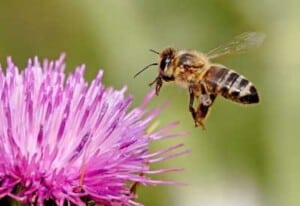There’s no more rewarding investment than planting apple trees. Trees that you plant early next spring may start yielding fruit in three to four years. But they’ll be giving joy almost immediately. Growing and caring for apples with your children can be especially rewarding. They’ll grow right along with your kids. A picture journal that begins at the first day of planting and continues through the years, with your kids standing right alongside their tree in each picture, will give your family memories that will last a lifetime, as will the tree itself.
Now you might be thinking that I’m jumping the gun here in late October. Nearly everyone recommends planting fruit trees in the spring, although you can get away with it in the fall if you have mild winters and protect the newly transplanted roots with plenty of mulch. But good organic practice starts in the fall even if your trees won’t go in the ground until spring. We went to the Maine Organic Farmers and Gardeners Association to find out more. Here (with some additions) is what they recommend.

A BESTSELLER!
Fruit Tree (5-5-2)
Use to promote hearty root development and robust fruit growth. NO synthetics!
$13.50Learn moreBackyard trees and shrubs are important components of your landscape. With our selection of natural tree care products you can give them the attention needed for strong growth and maximum blooming, not only at planting, but for a lifetime. Got bugs? Click on our Orchard & Tree Problems page for insect descriptions and a list of earth-friendly remedies.
Find a good location for your trees. Remember, unless you or your neighbor have nearby apple trees for pollination purposes, you’ll need to grow more than one. Apple trees need as much sun as they can get. Don’t plant them in the shade of a building or beneath other trees. The more air circulation a tree has, the less likely it is to develop blights and fungus. A slight slope where the air will “drain” downhill if it’s cool (or rise if it’s warm) is best.
Consider the soil. You should have a good two feet of loam to plant in even if the soil underneath is clay or otherwise hard-pack. The next step is a familiar one: start a compost pile where you’ll raise the tree. Break the soil up in an area a bit bigger than the size of a root ball. You might first want to throw down some rock phosphate to give your new tree the minerals it will need next spring. Some gardeners recommend throwing down lime or a source of calcium but don’t over do it. Apple trees like a slightly acidic soil — pH of 6.8 – 6.5 — though they’ll tolerate anything close. Then start working in as much organic material as you can until you have a modest compost heap. When spring comes, the ground will have plenty of good stuff for your tree and it will be more easily dug. If you’d rather not start a whole heap, throw down some compost where the tree will be planted. Do it again in the spring. The more beneficial microbes inhabit the soil where a tree is grown, the less likely it is that the tree will have problems.
The other thing to consider is which type of apple to plant. Turns out the type of tree you stick in the ground goes a long way to determining the problems (or lack of) they may have. The best source of information for this is you local nursery or university extension service. Best apples for Montana? Go here. Colorado? Indiana and the Midwest (PDF)? It’s always important to consider the micro-climate where your trees will be raised. That where a good nursery person comes in handy.
As for the planting itself? We’ll deal with that in March. Until then, here’s a short history of apples in America (with great illustrations). Note the role of heirlooms as discussed in the article. Did you know that the only native apple to North America is the crab apple? Neither did I. Also, contrary to the notion that Johnny Appleseed was a wandering sojourner who gave away his product, we find out that he was actually quite an entrepreneur. Now that’s American as apple pie.












